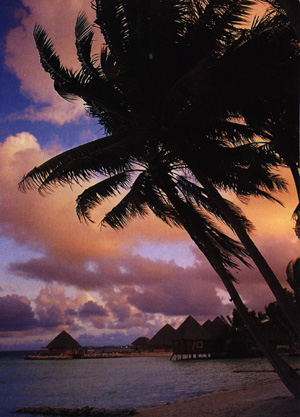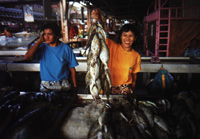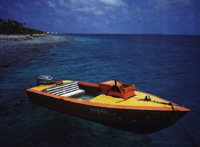From time immemorial the inhabitants of French Polynesia have lived in simple huts called fares (pronounced fah-rays). Like pointed caps, steeply slanted roofs thatched with artfully layered pandamus
fronds sit on rattan walls. The result is a dwelling perfectly suited to the climate of the fabled isles.
Then along comes Sofitel. The French hotel chain chooses the most spectacular sites, erects luxurious bungalows and calls them - what else? - fares I can imagine an islander shaking his head and saying, "My fare was never like this!"
I thought of this as I slipped out of my kiingsize bed, stepped into my bathing suit and staggered onto my private half moon deck. Inches below my feet the South Pacific took a deep breath and hightailed it for the horizon. When I wasn't looking a breeze as soft as cotton sneaked up and wrapped its arms around me. Just beginning to climb, the sun sprinkled the sea with silver coins as I imagined the papyayas, mangoes and guavas being spread out for my breakfast.
As it says in the brochures, "Welcome to Paradise."
Years ago James Michener is supposed to have called Bora Bora the most beautiful island in the world. Above my glorified fare an Air Tahiti plane was making its approach. As I had, I knew the passengers
were gazing in wonder at an almost unbroken circle of coral which seemed to have surfaced for no apparant reason in the middle of the Pacific. Outside the ring the water was deep navy blue, but inside, the lagoon was cobalt and robins egg and turquoise. Dead center like a mysterious bulls eye rose a gigantic prehistoric plug of lava, jagged and broken and totally awesome. Bora Bora is in the most spectacular phase of development from active volcano to creation of reef to disappearance of the dead volcanic remnants to outer coral atoll only, a process taking millions of years.
Some say the center island of Bora Bora is overdeveloped, but compared to Hawaii, for example, it is absolutely pristine. Besides, the lagoon is where the action is. Everyone experiences it, on or in or underneath, with activities ranging from glass bottom boats to diving with manta rays. For my money what Michener said then is just as true today.
For real development you have to go to Papeete, the capital of Tahiti. Gaughin did on June 18, 1891. So did Homer Morgan, A california ex-pat. His fame was gained in 1949 at the age of 24 by walking from coast to coast over the top of the island. In 1996 he rode an Isuzu.
It took only minutes to leave the 20th century behind. On either side of a rough dirt road, twisting roots and vines, gnarly tree trunks and leaves the shape and size of serving platters gave new meaning to the term "impenetrable jungle." This is what Homer had slogged through. "We walked in a lot of river beds," he said.
Some of which could be seen as we dined at the wilderness Relais de la Maroto. And silver ribbons of water falling down sheer volcanic walls of tufted clumps of lava, frozen where they had cooled, while
higher peaks vanished in the mist.
In the wlecome hut by the Manihi airstrip a young mother smiling with pride nursed her daughter while her older children delightedly touched the baby's face. Outside, Pacific blues, whites and greens were almost painfuly brilliant. The sun, milder than it looked, disappeared often behind billowing clouds and a soft breeze laid gentle fingers on willing victimes.
There is only one hotel on Manihi, the Pearl Beach Resort, and as elsewhere its overwater bungalows are by far the most special. Elegant constructions of natural woods, thick bamboo, skillfully woven fibers
and thatch, the centerpiece of each is a glass top cocktail table which can be lifted to feed brilliantly colored tropical fish without ever leaving your couch. Robinson Crusoe never had it like this.
Nor do the pearl farmers who live in rudimentary shelters at some 60 locations dotting the inner circumferance of the lagoon. Inserting irritants into living oysters, they thread them on lines and hang them
from scaffolds set up near the shore. The result is not white, but a lustrous deep grey pearl with highlights of green and lapis lazuli.
"C'est difficile, ce boulot, eh?" I asked a heavily muscled worker as he lowered another strand of shells into the lagoon. "Hard job, right?"
"Yes," he answered, "but it pays!"
"All right, everyone, say Ho-ah-hee-nay."
The Huahine Sofitel may be French but Tina wasn't and she wanted to be sure we pronounced her island's name the Polynesian way. I'd been told that Huahine was the most natural and unchanged of
all the islands I'd be visiting. Taumau (Tah-oo-mah-oo) Georges had a French last name, but was Huahine born and bred. It was he who took me to the maraes, the ancient temples of the Polynesiasn kings and had me sit in the scooped out lava that had served as their chairs. Then, in dense fields of vanilla plants he showed me how the flowers were pollinated by hand. And with a machete he made a delicate reed flute which he played on a historic stone platform overlooking the sea.
For a different aspect I sailed around the two adjacent islands in a Johnson Sea Horse powered outrigger canoe. Toward the ocean a filament of snow white surf tumbled over the distant reef. On shore palm studded hills rose sharply from slivers of sand. The line between the blue-black of deep water and blue-green opal of the shallows was etched as sharp as a knife. Just ahead I saw bright red and yellow bits of debris. Plastic, I thought sadly, and then found myself floating through a field of hisbiscus blossoms. Slipping into the lukewarm water I fed swarms of bottle nosed butterfly fish that fluttered around my hands like...butterflies. Eating the morsels until they were gone, they sucked the taste off my fingers for dessert.
Sitting at the Kia Ora Village hotel looking out at an azure sea you might think it goes on forever. You would be wrong. Rangiroa's lagoon is 46 miles long and 14 miles wide. Beyond the horizon is more -
Rangiroa. On Sunday in the town of Avatoru the tin roof church is full to overflowing. Husky men place wooden pews for visitors just outside the open doors. Inside, multicolored streamers stretch from wall to wall.
While the congregation lustily sings hymns a little girl wanders up and down the aisle, clutching a large green leaf to her chest.
After church we shoot the pass. Which means jumping from a boat into the mouth of the lagoon and letting the current sweep us toward the ocean. From the boat we've seen two manta rays, great black discs,
just below the surface. In the water they are among the missing. Not so surgeon fish, parrot fish, angels and a great many more extravagantly costumed fishes. As for sharks, they are out to lunch. At least the lunch isn't us.
"Kia Ora Sauvage is like sharing a tropical island with friends," said a young Japanese woman who had spent
two nights there with her mother. An hour by boat from the main hotel, Sauvage's five bungalows
have no electricity but a staff who attends to your every wish. When night casts its cape over the lagoon, all that is seen are pinprcks of light from kerosene lanterns. A someone else said, "It's a perfect place to get away with someone you're not supposed to be with."
Yes, French Polynesia has something for everyone, from the fanatically active to the absolutely indolent, from inveterate restaurant hoppers to escapees from civilization. For all it has fantastic beauty and air so sweet you can almost taste it. Perhaps in paradise it smells like this.
WHERE ARE THEY?
Tahiti is one of 115 islands that comprise French Polynesia. Spread over 1.5 million square miles in the South Pacific are 5 archepelagos: the Society Islands, including Tahiti, Bora Bora and Huahine, the Tuamotu Archipelago including Rangiroa and Manihi, the Austral Islands, the Marquesas Islands and the Gambier Islands.
HOW TO GET THERE:
Travel time to Tahiti from Los Angeles is about 7 hours. Times from Tahiti to: Bora Bora, 45 minutes. Huahine, 35 minutes. Rangiroa, 1 hour. Manihi, 1 hour, 40 minutes. Airlines from Los Angeles to Papeete, Tahiti are AOM French Airlines, 800 892-9136, Air New Zealand, 800 262-1234 and Air France, 800 237-2747.
WHEN TO GO:
There is a wet and dry season, but temperatures fluctuate only 12 to 14 degrees year round and are between 68 and 81 degrees (approxinately). The best time to go (dry season) is between mid May and mid October. The nearness to the equator can cause severe sunburn, so use sun screen.
WHAT TO WEAR:
The uniform is t-shirt, cap, shorts and sandals during the day. Evening wear is casual. Only rarely is a light sweater needed. Cap or wide brimmed hat, sun glasses and sun screen are musts as is mosquito repellent if going inland.
TIME:
When it is 10 A.M. in Tahiti it is noon in Los Angeles, 1 P.M. in Denver, 2 P.M. in Chicago and Houston and 3 P.M. in New York. It is one hour later during daylight savings time.
RECOMMENDED READING:
"Frommer's South Pacific" gives excellent basic island by island information by Bill Goodwin, a writer who has been there and done his homework. Published by Macmillan Travel. The Moon "South Pacific Handbook" has more detailed information with emphasis on activities, outdoor and other, history and culture as well
as accomodations and restaurants.
TO BOOK:
Accommodations, flights, tours, etc. can all be booked through Tahiti Vacations, 800 553-3477, 310 337-1040 in California.
FOR FURTHER INFORMATION:
Contact Tahiti Tourism, 300 N. Continental Blvd., Suite 180, El Segundo, CA 90245, tel. 310 414-8484.




